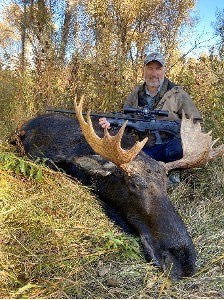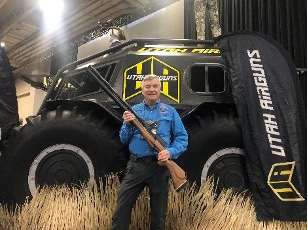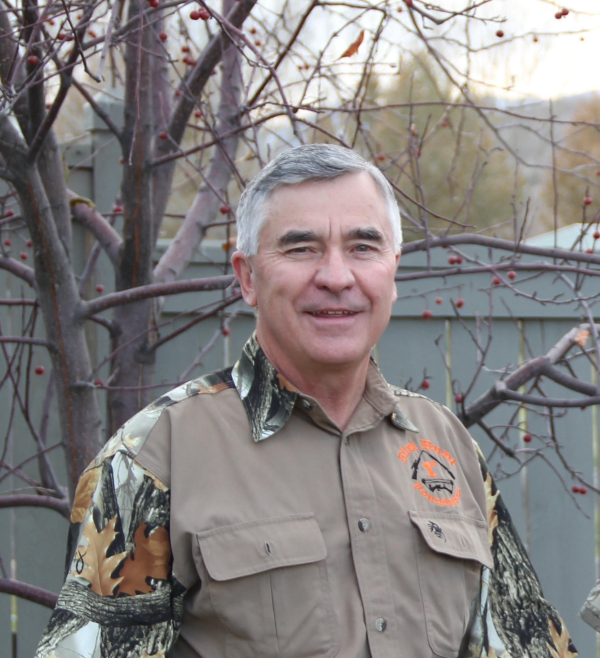By Rick Brazell - First Hunt Foundation
Most hunters of my generation, growing up in the 1960s, started their shooting journeys with a Daisy or Red Rider BB gun. All my friends had them, and we learned to shoot in backyards and pastures as we refined our marksmanship, shooting at dirt daubers and wasps, and soon even sparrows became fair game. Later, some of us moved onto .177 or .22 caliber pellet guns, discovered we had even more power in our young hands, and could now reach out further than we ever imagined. The chance to potentially harvest rabbits, bullfrogs, and doves spurned our imaginations to believe we could be hunters and bring some food home to the family's table. It didn't happen often, and there never seemed enough to feed an entire family, but the feeling of accomplishment couldn't be denied as that hunting spirit was nurtured.
Inevitably, young shooters and hunters of that day were allowed and hopefully encouraged to move onto .22 rimfires, and the smell of freshly shot gunpowder would forever change our identities. The energy of explosive powder became additive, and the lackluster performance of lead or a copper BB being propelled by a push of air seemed insignificant or at least no longer appreciated. Powder was power; its limits were only the cost of acquiring the hardware or the amount of recoil a person could handle comfortably.
As a young high school student, I recall saving my limited funds and walking into a Western Auto store in our small Texas town and buying a Ruger Super Blackhawk .44 magnum. No questions were asked, and parents were not required to sign for anything back then. Shooting that gun and especially showing its awesome power to all my friends was exhilarating and deafening, as my current hearing aids will attest. The point is that the power and effectiveness of powder have become entrenched in shooters and hunters for decades.
So why would we even consider the perception of going backward and looking at air-powered projectiles again? I would have never even asked myself that question if my good friend Rocky Mease hadn't shown me the picture of his Idaho bull moose and then exclaimed he shot it with his .45 caliber airgun.

Idaho Moose harvested with .45 caliber air rifle
|
You did what? Oh, and he shot his bear with the same gun the season before. That piqued my interest because something didn't seem right. How could that be? A giant bull moose and a mature black bear were taken down with an air rifle! Telling all my friends and associates the story got the same response, so I needed to research this apparent evolution and resurgence of air power.
In my research, I was also surprised to find that air rifles had been around long, long before we got that twinkle in our eyes to cock our BB guns and go chasing things outside. The oldest mechanical air gun, dating back to about 1580, is in the Livruskammaren Museum in Stockholm, Sweden. Most folks don't know that Lewis & Clark packed an air rifle with them on their famous expedition across the new frontier. I didn't believe it until I was shown the proof. Folks, this was 1804-1806! You can read about this famous air gun in their journals, which were the center of excitement and controversy from the outset of the expedition. The air gun described was thought to have been designed by C.G. Girandoni and adopted by the Austrian military in the late 1700s. This particular gun had a small air tank that held 800 p.s.i. of air pressure delivered by a rod-piston pump device needing 1,500 strokes to reach capacity. Can you feel the burn? However, once filled, the gun held 22 -.46 caliber lead balls that, when working properly, could fire all 22 shots in under a minute. It is written that Meriwether Lewis would consistently demonstrate the air gun to any of the natives encountered, causing some historians to speculate it was enough to keep them safe from later attacks. They never told those curious onlookers that they only processed one such gun, leading the amazed observers to think they likely had an armory of similar guns in their boats that each man could then use to take out 22 of their people. That could plant a seed of fear.
Modern-day air rifles are impressive. The size, distance, and energy produced now are hard to comprehend. On September 9, 2023, in New Mexico, Ton Jones shot a .30 caliber Airforce Texas model to set a new world record by hitting a 3-foot x 3-foot steel target at 2,058 yards. That's 1.169 miles! I recently attended the Western Hunting & Conservation Expo, where Utah Airguns showed me the AEA Zeus .72 caliber air gun.

Author holding a .72 caliber AEA Zeus
|
I was informed it was the largest air gun on the market then and would be used to hunt cape buffalo. Given this gun shoots an 850-grain bullet at 870 fps and delivers 1500-foot pounds of energy, I suspect it would work. While writing this article, I was informed that AEA is releasing a new .95 caliber model, Zeus. I watched their video on this gun where you can shoot up to a 2,500-grain (no joke) slug at 830 fps, producing a whooping 3,500+ foot-pounds of energy. Their representative made a great quote in their promotional video: "God knows why you need that much energy for anything on planet Earth, but you have it if you need it." Ok, if they eventually clone T-Rex again and they're in the woods, I'm in.
Utah Airguns was officially founded in 2016 by Justin Jacobson and since then has been taking the airgun world by storm. Justin told me "The airgun growth the past few years has been exponential. It has been due to the exposure we've been able to cross with the shooting industry." John McCaslin, President of Texas based Airforce Airguns expressed to me a similar response at Shot Show saying they are continuing to grow and expand not only in the US, but across the world. Airforce Airguns recently returned from the IWA Outdoors Classic in Nuremberg, Germany where they successfully promoted their products in front of trade visitors from 120 countries.
For us everyday hunters who won't be shooting things a mile away or needing a gun big enough to bring down a charging elephant, there are now many choices, and the industry's choices are expanding rapidly. A great place to start your research for finding your new air gun is Air Gun Depot at https://www.airgundepot.com/. They do a great job of breaking it down for hunters looking for big, medium, and small game guns. Big game such as deer and hogs have choices with a minimum of 90-200 FPE, where they list nine brands and 57 models from which to choose. Medium game models, which include guns with a minimum of 25 FPE, cover 19 brands and 143 models. Raccoons, bobcats, and other small predators can be taken with them. The small game category has 16 different brands and 99 models. These models have a minimum FPE of 11 and can be used for rabbits and squirrels. Prices range from under $200 for some small game models to around $1,700 for the big game models. Another great site to explore is Utah Airguns at https://utahairguns.com/. They show 17 brands with 242 models, including a couple of custom-built ones covering 14 different calibers. There are even air guns that shoot arrows, which some states now allow disabled hunters to use for archery. So, your choices are wide and far if you consider adding air power to your hunting inventory.
Now, some may ask the "Why?" question. "My powder-fired guns are working just fine. My freezer is full." might be a common response. Well, it would likely never be a choice of switching from powder to air but more a choice of expanding or adding to your existing portfolio of hunting arms. Most of us have multiple calibers that can be interchanged according to species hunted, terrain, distances, etc. We're all comfortable making choices whenever we go into the woods to hunt. The challenge of harvesting an animal with air power might appeal to some. The lack of government red tape for purchasing one might appeal to others. Buying a gun that can take down an elk and having the gun delivered to your front door seems strange but satisfying. No FFL is needed. Having a gun with little recoil and no loud muzzle blast as the same gun you will have a young hunter hunt with could be another reason. It might be great for training as well. Having working guns for an ammo crisis might be another reason.
Airguns are now an efficient, modernized tool for harvest like firearms, muzzleloaders, and archery equipment and many believe they should be taxed similarly to firearms and bows but some in the industry are resistant. Even the state fish and wildlife agencies acting via the Association of Fish & Wildlife Agencies passed a resolution last Sept. titled “CALLING FOR AMENDMENT OF THE PITTMAN-ROBERTSON FEDERAL AID IN WILDLIFE RESTORATION ACT TO INCLUDE AIRGUNS AND ASSOCIATED AMMUNITION” which states: “…BE IT FURTHER RESOLVED, that the Association of Fish and Wildlife Agencies encourages Congress to amend the Federal Aid in Wildlife Restoration Act to extend the federal excise tax to airguns and associated ammunition.” For now, airguns are exempt from these taxes so watch to see if modern airguns are brought into the fold saying they too are part of the shooting/hunting family of industries providing funds to help states help manage animals and habitats.
The facts are in, and the evidence just gets more compelling each year that there are now great new choices for hunters that weren't there just a few years back. Some states are more accepting of airgun hunting than others. The Airgun Sporting Association provides all the information you will need at https://airgunsporting.org/laws/, so check them out to see what species can be legally hunted with airguns in your state. The Europeans are way ahead of us with this technology. Still, it's time hunters in America start to embrace the power of air in bringing food to the table, even without the mesmerizing smell of burnt powder. I know I would miss that and be unable to tell my friends to "keep your powder dry!" but I'm game to try it at least. Thus far, my German-made RWS Diana 34 .22 caliber rifle has found its mark with rabbits and some pesky critters trying to damage my log home, but it's time to think bigger. I'll tell you how that turns out when it hits the air.

Jon Zinnel, Federal Ammunition
Dan Forster, Archery Trade Association
Brent Miller, Congressional Sportsmen’s Foundation
Rick Brazell, First Hunt Foundation
Mark Peterson, Worldwide Trophy Adventure
Michelle Scheuermann, Bullet Proof Communications
Facilitators
The Voice of Leadership Panel is an appointed group of outdoor industry leaders who have volunteered to contribute their voices on crucial hunting and outdoor recreation issues to inform, inspire, and educate participants within our community.